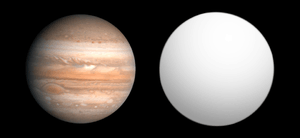WASP-11b/HAT-P-10b
| Exoplanet | List of exoplanets | |
|---|---|---|
 | ||
| Parent star | ||
| Star | WASP-11/HAT-P-10[1] | |
| Constellation | Perseus | |
| Right ascension | (α) | 03h 09m 28.5432s[2] |
| Declination | (δ) | +30° 40′ 24.853″[2] |
| Apparent magnitude | (mV) | 11.89 |
| Distance | 440±30[2] ly (130±10[2] pc) | |
| Spectral type | K3V[3] | |
| Orbital elements | ||
| Semi-major axis | (a) | 0.0439+0.0006 −0.0009[4] AU |
| Eccentricity | (e) | 0[4] |
| Orbital period | (P) | 3.7224690 ± 0.0000067[4] d |
| Inclination | (i) | 88.5 ± 0.6[4]° |
| Time of transit | (Tt) | 2454729.90631 ± 0.00030[4] JD |
| Semi-amplitude | (K) | 69.1 ± 3.5[4] m/s |
| Physical characteristics | ||
| Mass | (m) | 0.460 ± 0.028[4] MJ |
| Radius | (r) | 1.045+0.050 −0.033[4] RJ |
| Density | (ρ) | 498 ± 64[4] kg m−3 |
| Surface gravity | (g) | 10.5[4] m/s² |
| Temperature | (T) | 1030+26 −19[4][note 1] |
| Discovery information | ||
| Discovery date | April 1, 2008 (announced) September 26, 2008 (preprints) | |
| Discoverer(s) | West et al. (SuperWASP) Bakos et al. (HATNet) | |
| Discovery method | Transit | |
| Discovery site | SAAO | |
| Discovery status | Independently confirmed | |
| Other designations | ||
WASP-11b, HAT-P-10b | ||
| Database references | ||
| Extrasolar Planets Encyclopaedia | data | |
| SIMBAD | data | |
| Exoplanet Archive | data | |
| Open Exoplanet Catalogue | data | |
WASP-11b/HAT-P-10b or WASP-11Ab/HAT-P-10Ab[5] is an extrasolar planet discovered in 2008. The discovery was announced (under the designation WASP-11b) by press release by the SuperWASP project in April 2008 along with planets WASP-6b through to WASP-15b, however at this stage more data was needed to confirm the parameters of the planets and the coordinates were not given.[6] On 26 September 2008, the HATNet Project's paper describing the planet which they designated HAT-P-10b appeared on the arXiv preprint server.[4] The SuperWASP team's paper appeared as a preprint on the Extrasolar Planets Encyclopaedia on the same day, confirming that the two objects (WASP-11b and HAT-P-10b) were in fact the same, and the teams agreed to use the combined designation.[1]
The planet has the third lowest insolation of the known transiting planets (only Gliese 436 b and HD 17156 b have lower insolation). The temperature implies it falls into the pL class of hot Jupiters: planets which lack significant quantities of titanium(II) oxide and vanadium(II) oxide in their atmospheres and do not have temperature inversions.[7] An alternative classification system for hot Jupiters is based on the equilibrium temperature and the planet's Safronov number.[note 2] In this scheme, for a given temperature, class I planets have high Safronov numbers and tend to be in orbit around cooler host stars, while class II planets have lower Safronov numbers.[8] In the case of WASP-11b/HAT-P-10b, the equilibrium temperature is 1030 K[note 1] and the Safronov number is 0.047±0.003, which means it is located close to the dividing line between the class I and class II planets.[4]
The planet is in a binary star system, the second star is WASP-11 B, with a mass 0.34 ±0.05 of the Sun and a 3483 ±43 temperature.[9]
Notes
See also
References
- 1 2 Schneider, J. "Notes for star WASP-11/HAT-P-10". The Extrasolar Planets Encyclopaedia. Archived from the original on 2008-10-01. Retrieved 2008-09-29.
- 1 2 3 4 Brown, A. G. A; et al. (2016). "Gaia Data Release 1. Summary of the astrometric, photometric, and survey properties". Astronomy and Astrophysics. 595. A2. arXiv:1609.04172. Bibcode:2016A&A...595A...2G. doi:10.1051/0004-6361/201629512. Gaia Data Release 1 catalog entry
- ↑ West, R. G.; et al. (2008). "The sub-Jupiter mass transiting exoplanet WASP-11b". Astronomy and Astrophysics. 502: 395–400. arXiv:0809.4597v1 [astro-ph]. Bibcode:2009A&A...502..395W. doi:10.1051/0004-6361/200810973. Cite uses deprecated parameter
|class=(help) - 1 2 3 4 5 6 7 8 9 10 11 12 13 Bakos, G. Á.; et al. (2009). "HAT-P-10b: A Light and Moderately Hot Jupiter Transiting A K Dwarf". The Astrophysical Journal. 696 (2): 1950–1955. arXiv:0809.4295. Bibcode:2009ApJ...696.1950B. doi:10.1088/0004-637X/696/2/1950.
- ↑ West, R. G; Collier Cameron, A; Hebb, L; Joshi, Y. C; Pollacco, D; Simpson, E; Skillen, I; Stempels, H. C; Wheatley, P. J; Wilson, D; Anderson, D; Bentley, S; Bouchy, F; Enoch, B; Gibson, N; Hébrard, G; Hellier, C; Loeillet, B; Mayor, M; Maxted, P; McDonald, I; Moutou, C; Pont, F; Queloz, D; Smith, A. M. S; Smalley, B; Street, R. A; Udry, S (2011). "The HARPS search for southern extra-solar planets XXXIV. Occurrence, mass distribution and orbital properties of super-Earths and Neptune-mass planets". arXiv:1109.2497 [astro-ph.EP].
- ↑ "WASP Planets". SuperWASP. Retrieved 2016-01-26.
- ↑ Fortney, J. J.; et al. (2008). "A Unified Theory for the Atmospheres of the Hot and Very Hot Jupiters: Two Classes of Irradiated Atmospheres". The Astrophysical Journal. 678 (2): 1419–1435. arXiv:0710.2558. Bibcode:2008ApJ...678.1419F. doi:10.1086/528370.
- ↑ Hansen, B. M. S. & Barman, T. (2007). "Two Classes of Hot Jupiters". The Astrophysical Journal. 671 (1): 861–871. arXiv:0706.3052. Bibcode:2007ApJ...671..861H. doi:10.1086/523038.
- ↑ Open Exoplanet Catalogue WASP-11 20b
External links
![]()